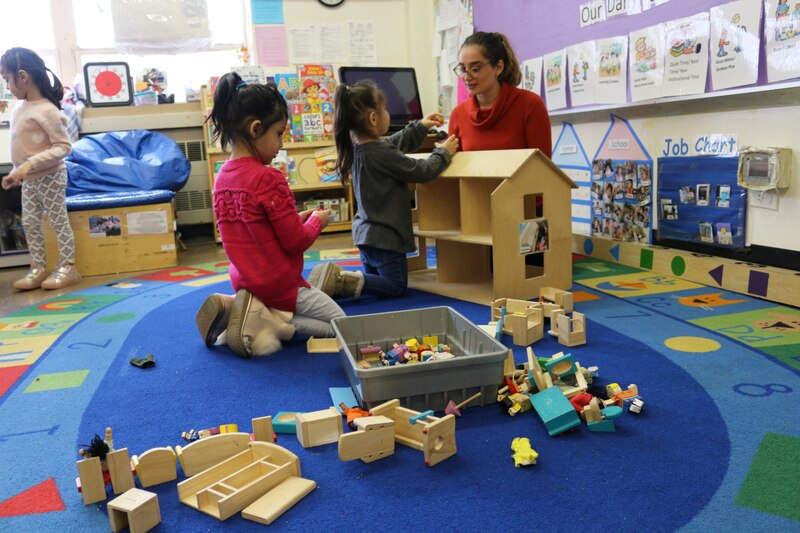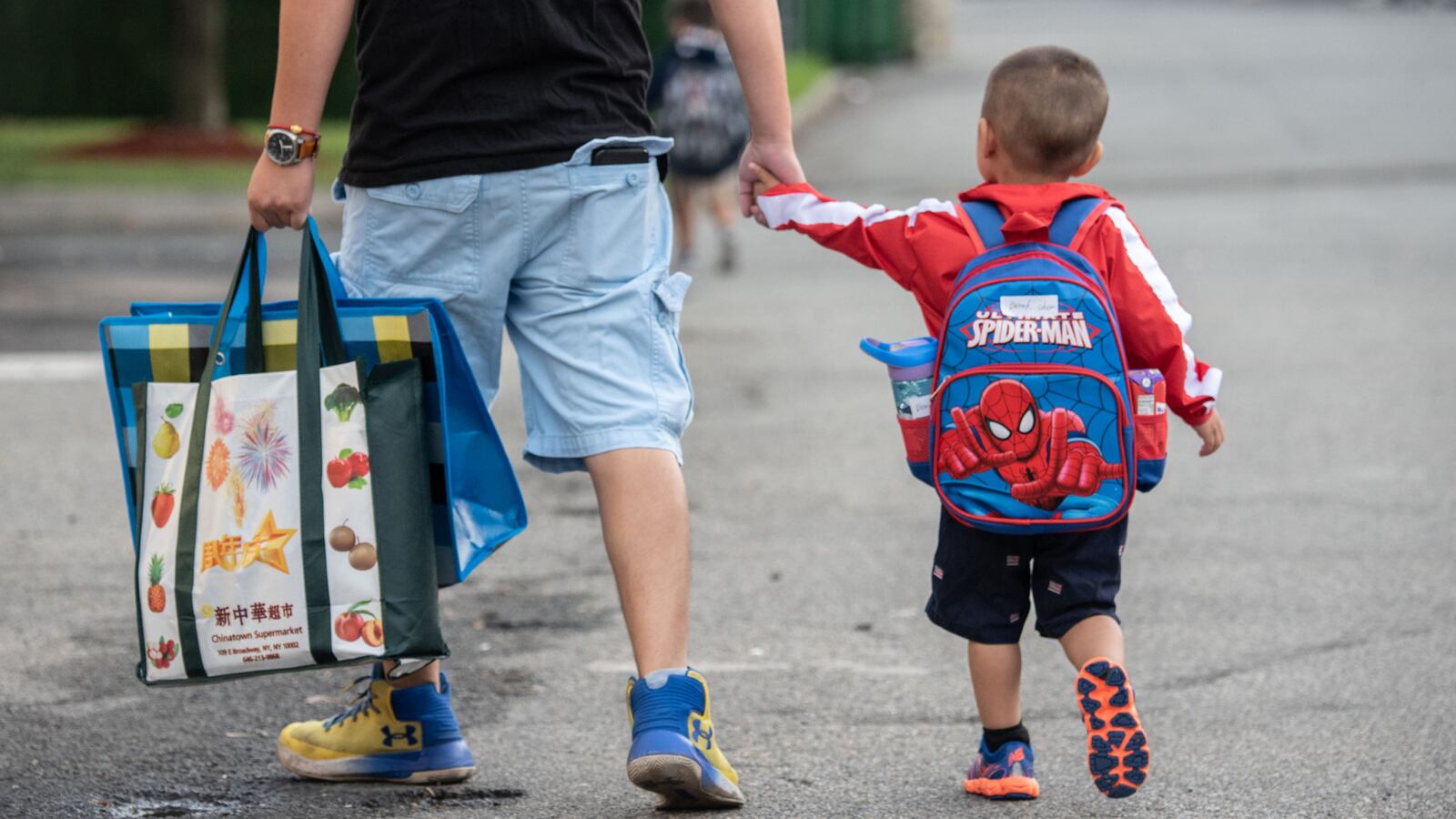This is part of an ongoing collaborative series between Chalkbeat and THE CITY investigating learning differences, special education and other education challenges in city schools.
As many as 2,000 students with special needs could be left without an appropriate pre-kindergarten seat this spring, as New York City’s education department has not met demand, and private providers have struggled to keep their doors open.
Even as Mayor Bill de Blasio has championed universal pre-K, which now covers all 4-year-olds, preschoolers with disabilities often sit at home for weeks or months — leaving them without supports during a crucial developmental period.
The looming shortage is estimated at roughly 1,000 to 2,000 seats in coming months, according to a report released Thursday by Advocates for Children, with the Bronx facing the greatest potential shortage of any borough.
“The most common scenario we’ve seen is children sitting at home with no instruction and no services,” said Randi Levine, policy director for Advocates for Children. “Students also end up staying in regular pre-K classes that are too large or without teachers that have the right training.”
Many 3- and 4-year-old students with disabilities learn in general education classrooms and receive extra services. But students with more intensive needs can be designated for smaller special education classes — mostly run by nonprofit community organizations — and the city is facing an acute shortage of those seats.
One major cause: More than 30 community-based preschools for students with disabilities have shut their doors in and around the city since 2014, amid years of nearly flat financing from the state.
There were roughly 16,500 remaining special education seats in private preschool classrooms last year, according to the city’s education department. While the city added 1,000 seats in public pre-K programs in the past two years, it has not made up for losses elsewhere in the system.
Adding to strain on community-based preschools, providers are struggling to hire teachers who can earn thousands of dollars more by working in the city’s own pre-K classrooms. And even when they do find teachers, some classrooms have remained empty because of a months-long backlog in getting background checks cleared.
“Those children that we promised seats to are sitting at home waiting,” said Carol Verdi, vice president of education services for HeartShare, which runs four special education preschool programs across the city. “I have parents calling every day crying.”

‘Start all over again’
Three-year-old Aiden Flores, who has autism and is nonverbal, has been at home in East New York without services since December, when he aged out of Early Intervention services for children with disabilities and became eligible to enroll in preschool.
Even though the education department determined last October that Aiden needed a special education placement with a smaller class size, they have been unable to offer him one, leaving him without any instruction or the speech and behavior therapy that was helping him become more expressive and social.
“I did my own research, I was calling schools,” said Juanita Lopez, Aiden’s mother. “And I’m like, ‘What do you mean? You don’t even have one for me to tour?’”
Officials at Advocates for Children, which is helping the family, said the education department is exploring options and offered a seat in a classroom that has twice as many students as Aiden’s special education learning plan calls for — an imperfect option Lopez is reluctant to accept.
In the meantime, Lopez worries her son is losing ground.
“He’s retreating back into his old self,” Lopez said, referring to a time when Aiden struggled to engage with adults or even gesture to make his needs known. “He’s going to lose what he got, and he’ll have to start all over again.”
Task force mania
Funding for private special education preschools is set and paid for by the state government, which in turn gets reimbursed 40% of the annual tab by the city and other counties across New York.
A closer look at what’s plaguing these preschools shows a striking pattern dating back more than a decade. State officials have convened task forces that recommend changes to funding rates or reimbursement methodologies — but no notable overhauls have occurred.
“It’s frustrating for all the agencies,” said Ken Cerini, managing partner of Cerini and Associates — a Long Island accounting firm that works with special education providers.
In November 2007, a temporary task force on preschool special education recommended the establishment of a “new rate-setting methodology, using principles already being practiced by other service systems in New York State to promote greater predictability and improved timeliness.”
Two months later, the state Board of Regents determined that the State Education Department and State Division of the budget should convene a second workgroup “to work out the details of the recommended methodological changes.”
But those efforts stalled. Following the 2008 financial recession, state officials froze the annual rate growth and cost of living increases for most human services providers starting with the 2009-10 budget.
While most providers had the freeze lifted within a few years, private special education preschool providers endured six straight years without a funding increase — through the 2014-15 state budget.
This was in part because the industry was facing intensive scrutiny of its financial practices at the time in the wake of a series of major fraud and fiscal abuse cases uncovered by the state Comptroller’s Office.
The attention prompted state officials to launch another preschool task force to review the funding methodology, but the report released by the task force in December 2014 focused largely on the fact that the industry was beset by financial woes and shortfalls in reimbursement.
“Concerns exist that this funding gap may ultimately affect the quality and availability of preschool special education services,” the report found, adding ”Many have stated they are in jeopardy of closing without financial relief.”
Since 2015-16, the state Division of Budget has approved a 2% annual rate increase for special education preschool providers. That’s less than the boost for public schools or for private providers of special education classrooms for older kids. It’s also lower than the rate requested by the state Board of Regents each year, advocates say.
“The blame is not entirely [the State Education Department’s] — a lot of their proposals have to be approved by the state division of the budget,” said former state Rep. Steve Sanders, director of the Professional Agencies for Children’s Therapy Services. “Some of them are shot down by the governor’s fiscal people who have the ultimate sign-off on these rates and funding issues.”
In 2017, the state Board of Regents convened another panel — this time with a broader mandate to look at a host of early childhood issues.
The recommendation that came back on preschool special education providers mirrored prior findings.
“Reevaluate the funding for preschool special education to ensure there is sufficient funding to support the cost of services,” a September 2018 report by the panel says.
The state’s division of budget, which, unlike the state’s education department, is controlled by Gov. Andrew Cuomo, continued to pin program closures on cases of fraud. The state also claimed that enrollment in special education programs fell because children were enrolling in the city’s own pre-K classrooms.
“These programs provide valuable support and resources to students with disabilities,” said Freeman Klopott, a spokesperson for the budget division. “We continue to review the rate-setting methodologies and the ongoing need to help ensure these students have the resources they need.”
The department also noted that it has adopted some of the taskforce recommendations over the years, including streamlining the rate-setting process for providers.
But Chris Treiber, director of a coalition of private providers known as the Interagency Council of Developmental Disabilities Agencies, said the state’s claim of reduced enrollment is faulty because across all preschools in New York City it’s held steady at about 32,000 for students with disabilities.
“There have been recent reports of significant numbers of preschool students in need of special education services who did not receive them because the services were not available,” he said.
For the city’s part, education department spokesperson Danielle Filson emphasized that “we are committed to ensuring there is an appropriate class available for every child who needs one,” noting the city has added seats in the programs it oversees. She echoed advocates’ call for the state to increase payment rates for providers.
Next steps
Last month, the State Board of Regents requested $2.5 million from state lawmakers in the budget that starts Apr. 1 to hire a consultant to help develop a new rate methodology.
In the short term, they asked that the annual rate increase for private special education preschool providers be set at 3.6% — rather than 2% — a move that would cost $19.2 million.
Bronx mom Shawnette Brown knows the stakes of the annual funding battles firsthand.
Although Brown’s son had been enrolled in a general education preschool classroom, she struggled to find a special education preschool seat after an evaluation found he was eligible for additional support due to his autism.
“Getting turned down left and right, it was frustrating, it was devastating,” she said. “It took months to get him put into the new school.”
But once the placement came through, despite delays securing speech and occupational therapy, she said she began seeing big improvements.
“He’s verbal now,” Brown said. “He’s doing a lot better.”

